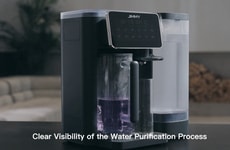Reverse Osmosis Dairy Filters – Trend Hunter

Report on DuPont FilmTec Hypershell XP RO-8038 and Its Contribution to Sustainable Development Goals
Introduction
DuPont has introduced the FilmTec Hypershell XP RO-8038, an advanced reverse osmosis (RO) solution designed specifically for the evolving needs of the dairy processing industry. This innovative technology focuses on the concentration and polishing of milk, whey, and lactose, aiming to enhance operational efficiency while supporting sustainability.
Key Features and Performance
- Enhanced Membrane Performance: The RO-8038 offers up to 50% better productivity and flow compared to previous membrane technologies.
- Energy Efficiency: It reduces energy demand by up to 50% during operation, contributing to significant energy savings.
- Operational Longevity: Designed to optimize durability, the solution extends the operational lifespan of membrane systems.
Alignment with Sustainable Development Goals (SDGs)
- SDG 7 – Affordable and Clean Energy: By reducing energy consumption by up to 50%, the FilmTec Hypershell XP RO-8038 supports the transition to energy-efficient industrial processes.
- SDG 9 – Industry, Innovation, and Infrastructure: The advanced membrane chemistry and expanded active area represent significant technological innovation in dairy processing infrastructure.
- SDG 12 – Responsible Consumption and Production: Enhanced productivity and operational longevity promote resource efficiency and waste reduction in dairy manufacturing.
- SDG 13 – Climate Action: The reduction in operational greenhouse gas emissions contributes directly to climate change mitigation efforts.
Industry Impact and Expert Commentary
Noel Carr, Global Dairy Marketing Leader for DuPont Water Solutions, emphasized the significance of this advancement:
“The FilmTec Hypershell XP RO-8038 element represents a significant advancement in membrane technology for dairy applications. With its innovative membrane chemistry and expanded active area, it empowers producers to achieve higher yields, lower costs, and more sustainable operations, contributing to an overall decrease in operational greenhouse gas emissions.”
Conclusion
The DuPont FilmTec Hypershell XP RO-8038 exemplifies how cutting-edge technology can drive sustainable development within the dairy industry. By aligning operational improvements with key Sustainable Development Goals, this solution supports energy efficiency, innovation, responsible production, and climate action, fostering a more sustainable future for dairy processing worldwide.
1. Sustainable Development Goals (SDGs) Addressed
- SDG 6: Clean Water and Sanitation – The article discusses advanced reverse osmosis technology aimed at improving water treatment processes in dairy processing, which relates to ensuring availability and sustainable management of water.
- SDG 7: Affordable and Clean Energy – The solution offers up to 50% less energy demand, contributing to energy efficiency and sustainable energy consumption.
- SDG 9: Industry, Innovation and Infrastructure – The advancement in membrane technology represents innovation in industrial processes.
- SDG 12: Responsible Consumption and Production – The technology enables higher yields and lower costs, promoting more sustainable production practices.
- SDG 13: Climate Action – The reduction in operational greenhouse gas emissions aligns with efforts to combat climate change.
2. Specific Targets Under the Identified SDGs
- SDG 6
- Target 6.3: Improve water quality by reducing pollution and minimizing release of hazardous chemicals and materials.
- Target 6.4: Increase water-use efficiency across all sectors.
- SDG 7
- Target 7.3: Double the global rate of improvement in energy efficiency.
- SDG 9
- Target 9.4: Upgrade infrastructure and retrofit industries to make them sustainable, with increased resource-use efficiency and greater adoption of clean and environmentally sound technologies.
- SDG 12
- Target 12.2: Achieve sustainable management and efficient use of natural resources.
- Target 12.5: Substantially reduce waste generation through prevention, reduction, recycling and reuse.
- SDG 13
- Target 13.2: Integrate climate change measures into policies and planning.
3. Indicators Mentioned or Implied in the Article
- Energy Efficiency Indicators
- Reduction in energy demand by up to 50% indicates progress towards Target 7.3.
- Water Use Efficiency Indicators
- Improved membrane performance with up to 50% better productivity and flow relates to water-use efficiency (Target 6.4).
- Greenhouse Gas Emissions
- Decrease in operational greenhouse gas emissions is an indicator relevant to SDG 13.2.
- Production Efficiency
- Higher yields and lower costs imply improved resource efficiency, relevant to SDG 12 targets.
4. Table of SDGs, Targets and Indicators
| SDGs | Targets | Indicators |
|---|---|---|
| SDG 6: Clean Water and Sanitation |
|
|
| SDG 7: Affordable and Clean Energy |
|
|
| SDG 9: Industry, Innovation and Infrastructure |
|
|
| SDG 12: Responsible Consumption and Production |
|
|
| SDG 13: Climate Action |
|
|
Source: trendhunter.com








